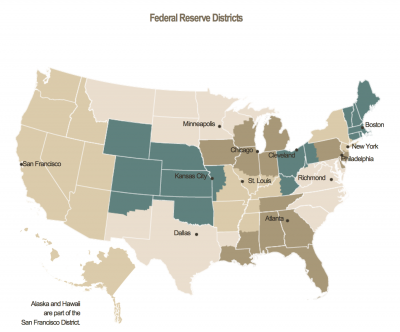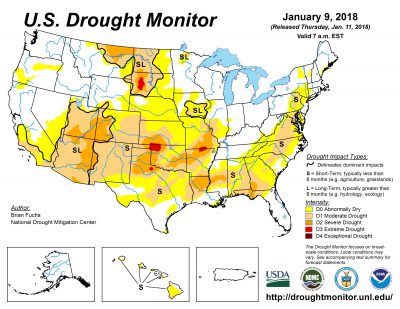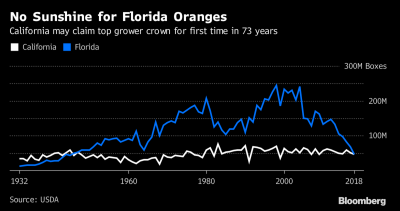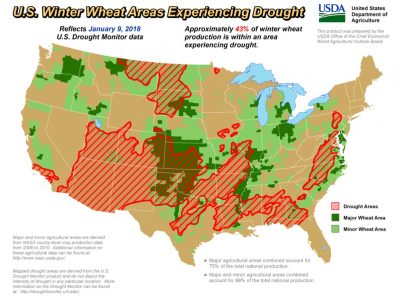Beef prices are projected to continue increasing as U.S. beef production declines with no signs of a cattle herd rebuild. Additionally, cheap beef may soon become further out of reach…
Federal Reserve: Observations on the Ag Economy- January ’18
On Wednesday, the Federal Reserve Board released its January 2018 Beige Book update, a summary of commentary on current economic conditions by Federal Reserve District. The report included several observations pertaining to the U.S. agricultural economy.

* Sixth District- Atlanta– “Agriculture conditions across the District were mixed. Drought conditions expanded in parts of Alabama, Florida, Georgia, Louisiana, and Mississippi and were classified as abnormally or moderately dry.”

“The District’s December cotton production forecast was up over last year, mostly because of increased acres, although there were some reductions in yields. The December forecast for Florida’s orange crops was down from the previous report. The USDA designated many counties in Florida and Georgia as natural disaster areas due to damages and losses attributed to Hurricane Irma.”

* Seventh District- Chicago– “Crop and dairy producers faced further belt-tightening at the start of 2018, while cattle and hog producers were in relatively better shape, owing to the underlying trends in prices received. Soybean prices dipped and corn prices rose over the reporting period, but both remained below last year’s levels as plentiful stocks kept a lid on prices.”
United States #Soybean Stocks, @usda_nass pic.twitter.com/HlpxnKOMFg
— Farm Policy (@FarmPolicy) January 12, 2018
United States #Corn Stocks, @usda_nass pic.twitter.com/rT1dEkGyHu
— Farm Policy (@FarmPolicy) January 12, 2018
“Looking ahead, lower fertilizer costs and slightly lower farmland rents provided limited improvement to crop producers’ profit expected margins.
Contacts indicated that challenging conditions had led to more financing requests from crop producers. Dairy producers also struggled, and some smaller and less efficient operations closed down.
“Cattle, egg, and hog prices moved higher, to the point that producers could earn profits.”
* Eighth District- St. Louis– “District agriculture conditions declined moderately from the previous reporting period. Due to unusually low temperatures across much of the District, the percentage of winter wheat rated fair or better fell 4 percentage points from the middle of November to the end of December; it is now 89 percent. Contacts are concerned that crop conditions worsened further during the first week of January, when temperatures plunged.”

* Ninth District- Minneapolis– “District agricultural conditions were stable at low levels. Recent estimates of farm income for District states were roughly unchanged from a year ago.”
#Farm sector profits forecast to stabilize in 2017, @USDA_ERS pic.twitter.com/yxmXpKwh9N
— Farm Policy (@FarmPolicy) January 17, 2018
* Tenth District- Kansas City– “Farm income expectations remained weak in most of the Tenth District, but the outlook for agricultural commodities was mixed. Revenues for corn and soybeans are expected to be slightly lower than last year due to lower prices and yields. Large inventories continued to weigh on prices, and District contacts reported lower yields due to abnormally dry conditions and wind damage.
Production expectations for winter wheat declined further since the last reporting period due to limited precipitation and extremely cold conditions that could cause freeze damage.
“Lower production expectations, however, supported moderately higher prices for winter wheat compared to a year ago. In the livestock sector, prices were higher than last year for cattle and hogs due to strong demand. Despite generally weak agricultural conditions, farmland values remained stable due to limited land sales. However, some bankers in the District expected more sales and declining values in the months ahead.”
* Eleventh District- Dallas– “The 2017 row crop harvest wrapped up, with generally favorable crop conditions after a dry spell in November. Texas cotton production was up notably from 2016 due to more acres planted and higher yields. Cotton prices rose over the past six weeks, and contacts expect the relatively strong prices to prompt a shift of more acres from grain to cotton this year. Agricultural producers remained concerned about revenue, as grain prices continued trending at unprofitable levels. Loan demand has been decreasing for the last two years while loan renewals and extensions have increased, according to the Dallas Fed Agricultural Survey.
Uncertainty about NAFTA is also a headwind for the agriculture sector, as many producers rely on export markets to move their production.
* Twelfth District- San Francisco– “On balance, activity in the agriculture sector improved modestly. Demand for organically grown crops remained strong. Conditions in the swine industry improved over the previous year. Farm equipment dealers reported higher-than-anticipated year-end demand based in part on an improved outlook. Crop yields in Central California slipped slightly at year-end, driven by the weak performance of certain nuts. The strong dollar continued to hold back exports of some agricultural commodities, particularly for wheat exports.”





